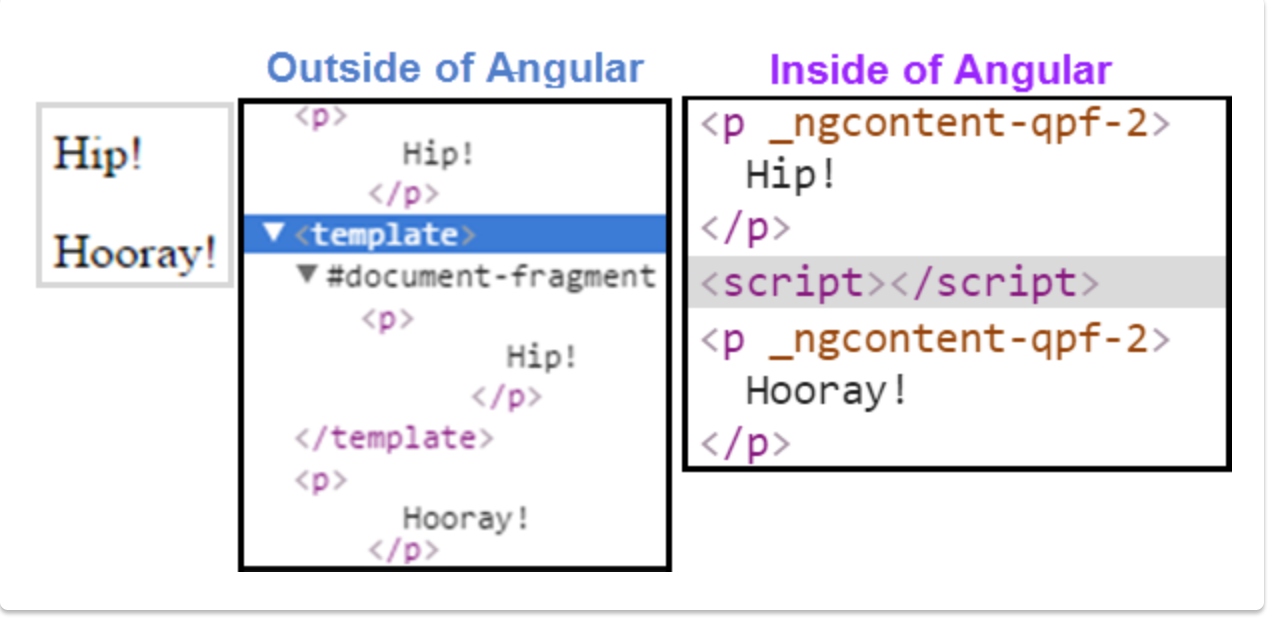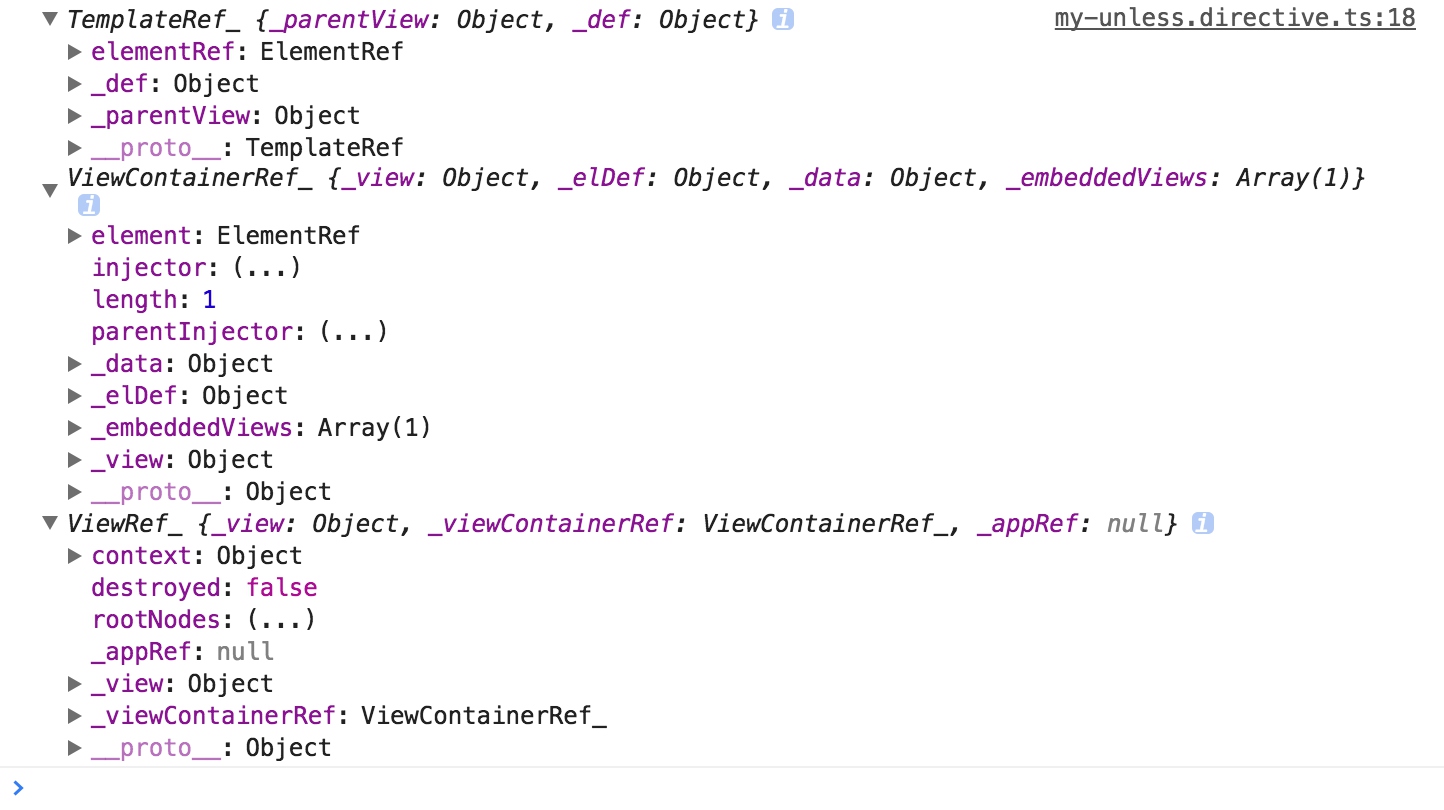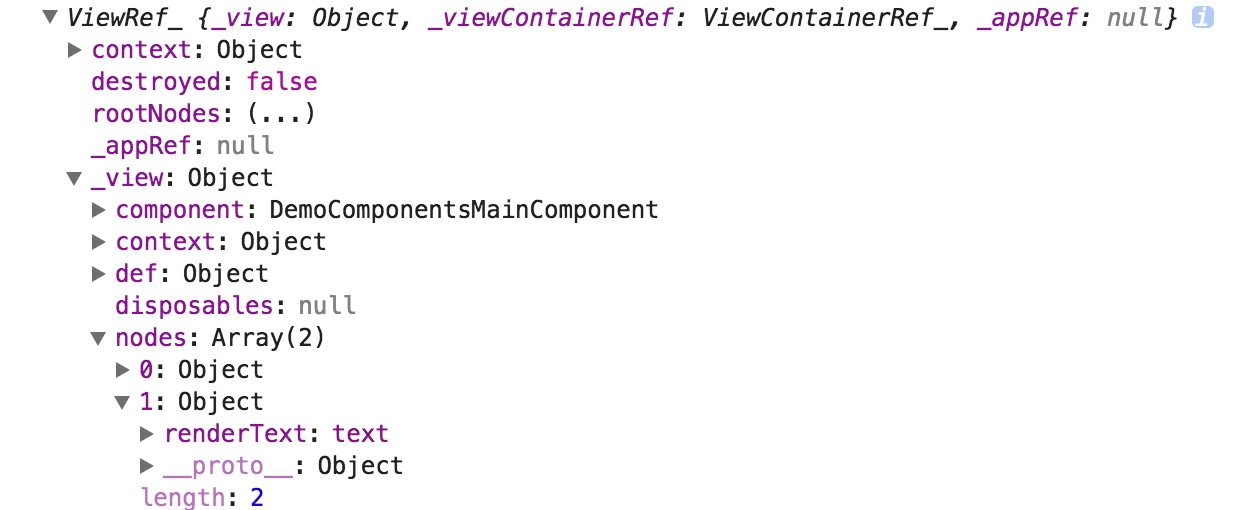Directives
Component is the sub class of Directive, it can be treated as a directive with template.
There are three kinds of directive
- Component - directives with template
- Attribute Directives - change the behaver or appearance of an existing DOM element
- Structural Directives - change the DOM layout
Lifefycle of directives
Some hooks exist in both component and directive
- ngOnInit
- ngOnChanges
- ngDoCheck
- ngOnDestroy
Some hooks only exist in component
- ngAfterContentInit
- ngAfterContentChecked
- ngAfterViewInit
- ngAfterViewChecked
Native Directives
There are directives offered by Angular including Common Directives, Router Directives and Form Directives.
Make a Attribute Directive
- A class with a
@Directuvedefined. - Match DOM elements with
selector. - Get the reference of the element with
ElementRefinjected in the constructor.
see Developing attribute directive for details.
Make a Structural Directive
Feature - an unless directive which will show the element when its value is false
it('should show element when `myUnless` is false', () => {
const fixture = createGenericTestComponent(`
<div class="content" *myUnless="false">Content</div>
`, TestComponent);
const el = fixture.debugElement.query(By.css('.content'));
expect(el).toBeTruthy();
});
it('should remove element when `myUnless` is true', () => {
const fixture = createGenericTestComponent(`
<div class="content" *myUnless="true">Content</div>
`, TestComponent);
const el = fixture.debugElement.query(By.css('.content'));
expect(el).toBeFalsy();
});
Error: No provider for TemplateRef! You missed the * in front of structural directive.
Create a directive with TemplateRef and ViewContainerRef injected
import { Directive, Input, ViewContainerRef, TemplateRef } from '@angular/core';
@Directive({
selector: '[myUnless]'
})
export class MyUnlessDirective {
constructor(
private tempalteRef: TemplateRef<any>,
private viewContainerRef: ViewContainerRef
) { }
@Input() set myUnless(unless: boolean) {
if (unless) {
this.viewContainerRef.clear();
} else {
this.viewContainerRef.createEmbeddedView(this.tempalteRef);
}
}
}
- tempalteRef is used to access the template
- viewContainerRef is the renderer
Structural directives, like ngIf, do their magic by using the HTML 5 template tag.
Outside of an Angular app, the tag's default CSS display property is none. It's contents are invisible within a hidden document fragment. Inside of an app, Angular removes the tags and their children. The contents are gone — but not forgotten as we'll see soon.


The asterisk (*) effect
The asterisk is “syntactic sugar”
<!-- Examples (A) and (B) are the same -->
<!-- (A) *ngIf paragraph -->
<p *ngIf="condition">
Our heroes are true!
</p>
<!-- (B) [ngIf] with template -->
<template [ngIf]="condition">
<p>
Our heroes are true!
</p>
</template>
Concepts
The HTML element is a mechanism for holding client-side content that is not to be rendered when a page is loaded but may subsequently be instantiated during runtime using JavaScript.
We use
<script id="tpl-mock" type="text/template">
<span>I am span in mock template</span>
</script>
tempalte tag in HTML5
<template id="tpl">
<span>I am span in template</span>
</template>
is suggested in angular

<ng-template>
<span>I am span in template</span>
</ng-template>
We fill a container with templte
<!-- Template Container -->
<div class="tpl-container"></div>
<!-- Template -->
<template id="tpl">
<span>I am span in template</span>
</template>
<!-- Script -->
<script type="text/javascript">
(function renderTpl() {
if ('content' in document.createElement('template')) {
var tpl = document.querySelector('#tpl'); // --> templateRef
var tplContainer = document.querySelector('.tpl-container'); // --> viewContainerRef
var tplNode = document.importNode(tpl.content, true);
tplContainer.appendChild(tplNode); // --> viewContainerRef.createEmbeddedView
} else {
throw new Error("Current browser doesn't support template element");
}
})();
</script>
HostBinding
Bind the property of the host element. Using a get function to update the HostBinding value when Input value changed.
@Input() myCollaspe = false;
@HostBinding('class.show') get showClass() { return !this.myCollaspe; }
TemplateRef, ViewContainerRef and EmbeddedViewRef
Results in browser when using structural directive

The displayed element existed in nodes property.

ViewContainerRef
/**
* @license
* Copyright Google Inc. All Rights Reserved.
*
* Use of this source code is governed by an MIT-style license that can be
* found in the LICENSE file at https://angular.io/license
*/
import { Injector } from '../di/injector';
import { ComponentFactory, ComponentRef } from './component_factory';
import { ElementRef } from './element_ref';
import { NgModuleRef } from './ng_module_factory';
import { TemplateRef } from './template_ref';
import { EmbeddedViewRef, ViewRef } from './view_ref';
/**
* Represents a container where one or more Views can be attached.
*
* The container can contain two kinds of Views. Host Views, created by instantiating a
* {@link Component} via {@link #createComponent}, and Embedded Views, created by instantiating an
* {@link TemplateRef Embedded Template} via {@link #createEmbeddedView}.
*
* The location of the View Container within the containing View is specified by the Anchor
* `element`. Each View Container can have only one Anchor Element and each Anchor Element can only
* have a single View Container.
*
* Root elements of Views attached to this container become siblings of the Anchor Element in
* the Rendered View.
*
* To access a `ViewContainerRef` of an Element, you can either place a {@link Directive} injected
* with `ViewContainerRef` on the Element, or you obtain it via a {@link ViewChild} query.
* @stable
*/
export declare abstract class ViewContainerRef {
/**
* Anchor element that specifies the location of this container in the containing View.
* <!-- TODO: rename to anchorElement -->
*/
readonly abstract element: ElementRef;
readonly abstract injector: Injector;
readonly abstract parentInjector: Injector;
/**
* Destroys all Views in this container.
*/
abstract clear(): void;
/**
* Returns the {@link ViewRef} for the View located in this container at the specified index.
*/
abstract get(index: number): ViewRef | null;
/**
* Returns the number of Views currently attached to this container.
*/
readonly abstract length: number;
/**
* Instantiates an Embedded View based on the {@link TemplateRef `templateRef`} and inserts it
* into this container at the specified `index`.
*
* If `index` is not specified, the new View will be inserted as the last View in the container.
*
* Returns the {@link ViewRef} for the newly created View.
*/
abstract createEmbeddedView<C>(templateRef: TemplateRef<C>, context?: C, index?: number): EmbeddedViewRef<C>;
/**
* Instantiates a single {@link Component} and inserts its Host View into this container at the
* specified `index`.
*
* The component is instantiated using its {@link ComponentFactory} which can be
* obtained via {@link ComponentFactoryResolver#resolveComponentFactory}.
*
* If `index` is not specified, the new View will be inserted as the last View in the container.
*
* You can optionally specify the {@link Injector} that will be used as parent for the Component.
*
* Returns the {@link ComponentRef} of the Host View created for the newly instantiated Component.
*/
abstract createComponent<C>(componentFactory: ComponentFactory<C>, index?: number, injector?: Injector, projectableNodes?: any[][], ngModule?: NgModuleRef<any>): ComponentRef<C>;
/**
* Inserts a View identified by a {@link ViewRef} into the container at the specified `index`.
*
* If `index` is not specified, the new View will be inserted as the last View in the container.
*
* Returns the inserted {@link ViewRef}.
*/
abstract insert(viewRef: ViewRef, index?: number): ViewRef;
/**
* Moves a View identified by a {@link ViewRef} into the container at the specified `index`.
*
* Returns the inserted {@link ViewRef}.
*/
abstract move(viewRef: ViewRef, currentIndex: number): ViewRef;
/**
* Returns the index of the View, specified via {@link ViewRef}, within the current container or
* `-1` if this container doesn't contain the View.
*/
abstract indexOf(viewRef: ViewRef): number;
/**
* Destroys a View attached to this container at the specified `index`.
*
* If `index` is not specified, the last View in the container will be removed.
*/
abstract remove(index?: number): void;
/**
* Use along with {@link #insert} to move a View within the current container.
*
* If the `index` param is omitted, the last {@link ViewRef} is detached.
*/
abstract detach(index?: number): ViewRef | null;
}